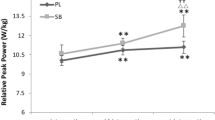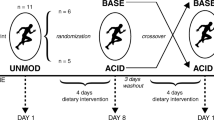Abstract
Electrolyte metabolism undergoes significant changes in trained subjects, but it is unknown if it undergoes significant changes in untrained subjects during hypokinesia (decreased movement). The aim of this study was to measure calcium (Ca) changes in trained and untrained subjects during prolonged hypokinesia (HK).
Studies were done during 30 d of a pre-HK period and 364 d of a HK period. Forty male trained and untrained volunteers aged 23–26 yr were chosen as subjects. All subjects were equally divided into four groups: trained ambulatory control subjects (TACS), trained hypokinetic subjects (THKS), untrained hypokinetic subjects (UHKS), and untrained ambulatory control subjects (UACS). The THKS and UHKS groups were kept under an average running distance of 0.7 km/d.
Fecal Ca excretion, urinary Ca and magnesium (Mg) excretion, serum ionized calcium (CaI), Ca, Mg, intact parathyroid hormone (iPTH) and 1,25 dihydroxyvitamin D [1,25 (OH)2 D] concentration, body weight, and peak oxygen uptake were measured. Fecal Ca loss, urinary Ca and Mg excretion, and serum CaI, Mg, and Ca increased significantly (p ≤ 0.01), whereas serum iPTH and 1,25 (OH)2 D concentration body weight and peak oxygen uptake decreased significantly (p ≤ 0.01) in the THKS and UHKS groups when compared with the TACS and UACS groups. The measured parameters were much greater and much faster in the THKS group than in the UHKS group. By contrast, the corresponding parameters did not change significantly in the TACS and UACS groups when compared with the baseline control values.
It was concluded that prolonged HK induces significant fecal, urinary, and serum Ca changes in the hypokinetic subjects when compared with control subjects. However, fecal, urinary, and serum Ca changes were much greater and appeared much faster in the THKS group than the UHKS group.
Similar content being viewed by others
References
A. V. Volozhin, Pathogenesis of disturbances of calcium metabolism in mineralized tissues during prolonged hypokinesia, Ph.D. thesis, “Interkosmos” Council, Academy of Sciences USSR and Directorate of Kosmic Biology and Medicine, Ministry of Health USSR, Moscow, (1978).
V. P. Krotov, Kinetics and regulation of fluid and electrolytes metabolism in animals and human beings during prolonged hypokinesia, Ph.D. thesis, “Interkosmos” Council, Academy of Sciences USSR and Directorate of Kosmic Biology and Medicine, Ministry of Health USSR, Moscow (1978).
A. I. Grigor’yev, Regulation of fluid and electrolytes metabolism and renal function in man during kosmic flights, Ph.D. thesis, “Interkosmos” Council, Academy of Science USSR and Directorate of Kosmic Biology and Medicine, Ministry of Health USSR, Moscow (1980).
A. I. Grigor’yev, B. R. Dorokhova, V. Yu. Semenov, B. V. Morokov, E. O. Baychorov, I. S. Skukina, et al., Fluid-electrolyte metabolism and renal function in kosmonauts following 185-day kosmic flight, Kosmicheskaya Biol. 19, 21–27 (1985).
Y. G. Zorbas, Y. F. Federenko, and K. A. Naexu, Renal excretion of fluid and electrolytes after potassium and calcium loading and during hypokinesia and physical exercise, Model. Simul. Control 41, 19–36 (1993).
Y. G. Zorbas, Y. F. Federenko, and K. A. Naexu, Calcium loading and renal function in trained subjects during restriction of muscular activity and chronic hyperhydration, Biol. Trace Element Res. 41, 137–156 (1994).
Y. G. Zorbas, K. A. Naexu, and Y. F. Federenko, Blood serum biochemical changes inphysically conditioned and unconditioned subjects during bed ret and chronic hyperhydration, Clin. Exp. Pharmacol. Physiol. 19, 137–145 (1992).
Y. G. Zorbas, Y. F. Federenko, and K. A. Naexu, Fluid electrolyte and hormonal changes in conditioned and unconditioned men under hypokinesia, Acta Astronautica 17, 1123–1126 (1988).
J. H. Lohman, A. F. Roche, and R. Martorell (eds.), Anthropometric Standardization Reference Manual, Human Kinetics, Champaign, IL (1988).
J. Brozek, F. Grande, J. T. Anderson, and A. Keys, Densitometric analysis of body composition, Ann. NY Acad. Sci. 110, 113–140 (1963).
I. V. Fedorov and L. A. Grishanina, Nitrogen metabolism in animals exposed to hypodynamia, Kosmicheskaya Biol. 1, 43–48 (1967).
I. V. Fedorov, V. N. Vinogradov, Yu. I. Milov, and L. A. Grishanina, Synthesis of tissue proteins in animals during hypodynamia, Kosmicheskaya Biol. 4, 18–21 (1970).
I. V. Fedorov, A. V. Chernyy, and A. I. Fedorov, Synthesis and catabolism of tissue proteins in animals during hypodynamia and resumption of muscular activity, Fiziol. Zh. SSSR 63, 1128–1133 (1977).
Y. G. Zorbas, G. E. Verentsov, and Y. F. Federenko, Renal excretion of end products of protein metabolism in urine of endurance trained subjects during restriction of muscular activity, Panminerva Med. 37, 109–114 (1995).
Yu. P. Ryl’nikov, Hypokinetic effect on lipid composition of blood and tissues of rabbits of different age, Kosmicheskaya Biol. 8, 8–13 (1974).
T. N. Lobova and A. V. Chernyy, Effect of physical loads on parameters of lipid and carbohydrate metabolism during hypokinesia, Kosmicheskaya Biol. 11, 36–40 (1977).
Y. G. Zorbas, A. L. Ivanov, and M. F. Fukuhara, Blood and lipid metabolism in rats under hypokinesia, Mater. Med. Polona 22, 275–279 (1990).
V. A. Tishler, V. M. Zatsiorskiy, and V. N. Seluyanov, Study of mass-inertia characteristics of human body segments during six month hypokinesia, Kosmicheskaya Biol. 15, 36–42 (1981).
Y. G. Zorbas, V. R. Bobylev, and A. N. Naexu, Physical exercise in preserving mens body mass under hypokinesia, Int. J. Rehab. Res. 12, 326–330 (1989).
Y. G. Zorbas, V. R. Bobylev, A. N. Marketi, and Y. F. Federenko, Body mass changes in endurance trained volunteers during prolonged restriction of muscular activity and chronic hyperhydration, Sports Med. Training Rehab. 4, 167–176 (1993).
Ye. V. Gushevas and R. Yu. Tashpulatov, Investigation of albumin and globulin composition of blood of the crew of Salyut-3 Station, Kosmicheskaya Biol. 13, 15–18 (1979).
Ye. V. Gushevas and R. Yu. Tashpulatov, Effect of flights of different duration on protein composition of kosmonauts blood, Kosmicheskaya Biol. 14, 13–17 (1980).
Y. G. Zorbas, Y. Y. Yaroshenko, O. L. Georgeascu, and M. N. Tanaka, Haemoglobin mass in men after hypokinesia and physical exercise with chronic hyperhydration, Model. Simul. Control 21, 43–56 (1990).
Author information
Authors and Affiliations
Rights and permissions
About this article
Cite this article
Zorbas, Y.G., Yarullin, V.L., Denogradov, S.D. et al. Serum, urinary, and fecal calcium changes in trained and untrained subjects during prolonged hypokinetic and ambulatory conditions. Biol Trace Elem Res 73, 211–229 (2000). https://doi.org/10.1385/BTER:73:3:211
Received:
Accepted:
Issue Date:
DOI: https://doi.org/10.1385/BTER:73:3:211




